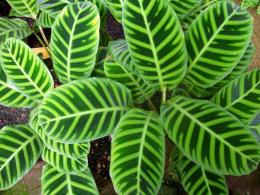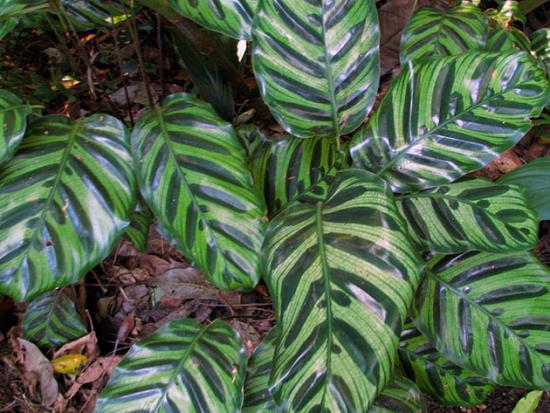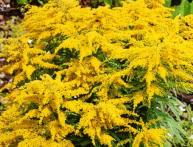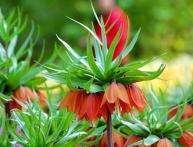Calathea striped: plant care, propagation rules and main pests

Calathea striped belongs to the arrowroot family.
Gardeners have fallen in love with this plant because of its unique coloring, as its leaves are a vibrant green color with varied stripes. They are often compared to peacock feathers.
Content:
Description of Calathea
The name of the plant has ancient Greek roots. Calathea looks very attractive.
Its leaves are large, which constantly turn towards the sunny side. The plant blooms in natural conditions from April and delights with its flowers until July, which come in different colors.

But the most important difference between calathea and other indoor plants is its large foliage.
So how to care It is quite difficult to look after such a flower; for this you need to take into account many nuances.
Plant care rules
In order for Calathea to please its owner, it is necessary to properly care for it. This plant is of tropical origin, so it loves warmth. It can develop quietly at high temperatures.
In winter, the plant can tolerate coolness, but the temperature should not drop below 18 degrees.
Calathea is a light-loving plant, but it does not like bright light. To decide on the place where to place the flower, you need to pay attention to its reaction.
Its leaves will turn pale if it doesn't get enough light. Gardeners advise placing calathea in the west or east.
It is better to select slightly acidic soil, the components of which will include:
- leaf soil
- a small part of humus
- sand
- peat
- there must be drainage
It is important to pay great attention to watering. Calathea has superficial roots. For this reason, it has special watering requirements.
After all, slight overdrying means the plant will die. It will initially begin to dry out, and the foliage will curl up. This is the number one grooming mistake people make.
Therefore, gardeners strongly recommend carefully monitoring soil moisture.
You need to water the plant with warm water. If cold water is used, the leaves will rot.
You can also spray the flower; this procedure has a positive effect on its condition.
Calathea loves moist air. To do this, you can use a spray bottle. In order for the flower to develop better, you need it regularly. feed, once every 2 weeks.
To do this, you can use a regular fertilizer intended for ornamental deciduous plants. It must be applied after watering.
Reproduction of the striped calathea plant
It is better to propagate calathea by dividing the root system. The procedure must be performed with extreme care.
To do this, break off part of the root and then place it in new soil. It should have several leaves.
There is another method of reproduction. The same part of the root is placed in a polyethylene bag and placed in heat. In this form, the plant will take root.
Calathea periodically needs ventilation; the package is disposed of when the flower begins to grow.A young plant also requires careful care.
Pests and diseases

From improper care, the plant can be affected by pests and diseases. If the air is not humid enough, the calathea may be attacked by spider mites, scale insects, and thrips.
In this case, the foliage of the plant begins to acquire a yellowish tint, and then completely falls off. The flower needs help, otherwise its death will come soon.
If a small cobweb or plaque is noticed, then you need to start taking certain measures.
To eliminate thrips and scale insect, the foliage is treated with a soap solution. Sometimes this procedure does not bring the desired result. In this case, you need to use an insecticide that is used to treat the plant.
Calathea leaves may begin to dry out. This doesn't happen by accident. If you dry the ends of the leaves, then you need to increase the air humidity.
To do this, the plant is sprayed. Dry spots may appear on the leaves, which indicate sunburn.
They appeared due to the fact that after spraying large splashes remained on the leaves. Calathea can also dry out due to lack of watering or strong drafts.
The plant may begin to turn yellow. If this change occurs exclusively on the lower leaves, do not worry, as this is normal. The old foliage begins to die so that new leaves can appear.
If the calathea turns yellow in other places, then you should worry. This may indicate improper watering or excessive feeding of the plant. Yellowness also occurs from heavy watering.
After it, the earth should dry out by 2 centimeters, only after that it is worth watering the calathea again.If it is flooded, the rhizome will rot and the foliage will turn yellow.
But you need to feed the plant in moderation. The 0.5 dose offered by the manufacturers will be enough for him. If calathea develops in cold conditions, then the foliage may also begin to turn yellow.
In some cases, the plant foliage curls. This occurs from cold or dry air. Drafts can also affect this change.
You may notice that any calathea ailment is associated with improper care. That is why this flower is considered capricious.
If you don't spend enough time on it, it will begin to die. To make it pleasing to the eye, you just need to follow all the rules of care. As soon as any changes appear, the plant needs to be helped.
Video about proper care of calathea:
Interesting information about the vegetable garden










